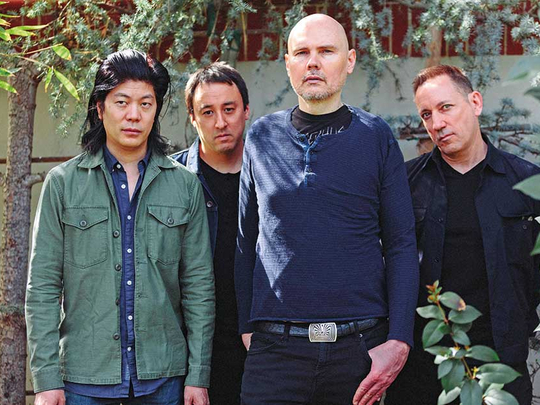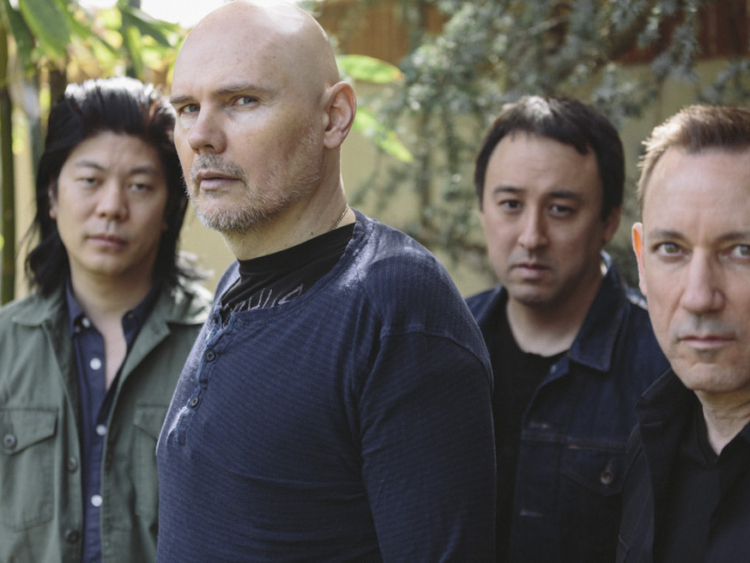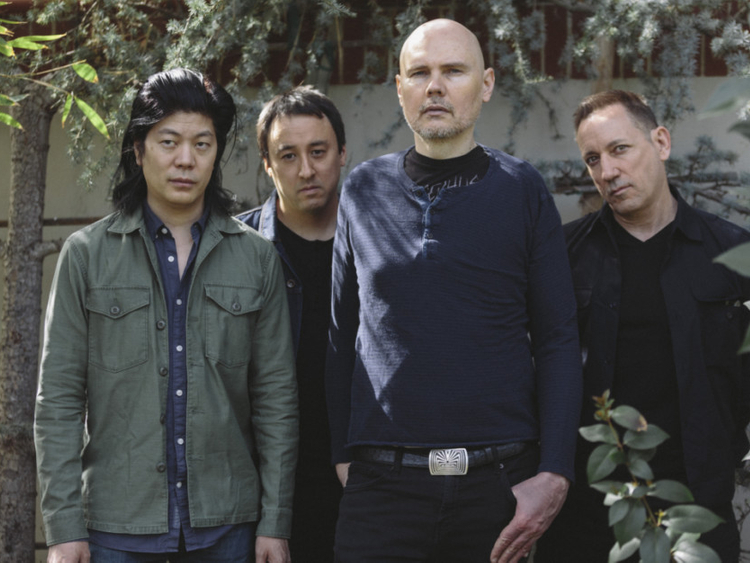
In the nearly two decades since the original lineup of the Smashing Pumpkins succumbed to rock-star cliches, crumbling under the weight of drugs, expectations and egos, the band’s lead singer, songwriter and guitarist Billy Corgan has kept himself plenty busy.
A confident mastermind with omnivorous ambitions, Corgan, 51, became a published poet; a professional wrestling executive and owner; a prolific Myspace and LiveJournal user; a curator of vintage photographs; an amateur talking head and recurring guest on Alex Jones’ Infowars programming; the proprietor of a Chicago-area tea shop; and a cat magazine cover star, among other side-hustles.
There was no shortage of music either, including two solo albums and one with Zwan, as well as various iterations of the Smashing Pumpkins that Corgan has kept afloat since declaring in a 2005 full-page newspaper ad: “I want my band back, and my songs, and my dreams.”
Yet, despite reviving the Pumpkins brand with additional albums and regular touring over the years, Corgan, as the only constant member, has never again sniffed the creative or commercial success of the band’s heyday. Amid four consecutive platinum albums in the 1990s, the grunge-adjacent group peaked by selling more than 10 million copies of Mellon Collie and the Infinite Sadness, a 28-track opus with no fewer than four era-defining hits, including Tonight, Tonight and Bullet With Butterfly Wings.
Looking back at the aftermath of those accomplishments, Corgan can admit now that he was a bit like Don Quixote, “wrestling with the ghost of the thing” and carrying on “a war that was very much my own war,” he said this month. “I was in denial about what I’d given up.”
So it was with some hard-won humility that Corgan allowed himself to realise a few years back that the Pumpkins were just not the same without original guitarist James Iha, who helped found the group as a Chicago teenager in 1988; Jimmy Chamberlin, the drummer who has been Corgan’s most frequent on-and-off collaborator; and bassist D’Arcy Wretzky.
After some tentative emails initiated by Iha — their first real contact since 2001 — and then a few air-clearing dinners, Corgan began the process of slowly piecing back together his core creative unit. With enough time past, and having each toiled with enough subpar substitutes, they made it work this time — and Corgan finally got his band back.
Almost. Because what would a Smashing Pumpkins reunion be without some drama?
Beginning in July, the original group — minus a discontented Wretzky — will set out on a 38-date (and growing) summer tour titled Shiny and Oh So Bright. And though the shows will coincide with the Pumpkins’ 30th anniversary and exclusively feature songs from their first five essential albums, it’s not all a nostalgia trip. Trying to make this more of a reboot than a reunion, the band has been in the studio with the guru-producer Rick Rubin at work on new songs, which likely will be released as two EPs before year’s end.
“I would say this is the happiest time of the band,” Corgan said, flanked by Chamberlin, who was relentlessly positive, and Iha, who seemed content to go with the flow.
The question now is whether fans — who have weathered years of diminishing returns from Corgan’s mercurial antics, broken promises and odd decisions — will allow themselves to trust the band enough to care. And assuming they do, how long can this infamously dysfunctional musical family hold it together?
“It’s a bit akin to trying to rekindle a romance almost two decades later,” Corgan said, away from his bandmates. “The love is there, but, you know, is the language? Is the magic there?”
In the studio, they decided, it most certainly was. The band put out a demo of 15 songs with hopes of perfecting one single with Rubin to publicise the tour; the producer ended up picking eight songs he wanted to record.
“The energy of the performances are fiery and vibrant,” Rubin wrote in an email, noting that the music “fits well with classic Pumpkin catalogue.” He added: “It’s not unusual for there to exist volatility with passionate, creative people. It seems like they’ve know each other long enough for many of the old wounds to have healed and they all seem like they are in a good place, so they came in with a healthy mindset.”
Chamberlin said the group’s disagreements had never been musical, so upon reuniting, the new songs “just poured out.”
Corgan concurred: “It picks up where this unit left off,” he said, adding that the fresh material saw him return to “the Zero character” he had used to write some of the Smashing Pumpkins’ most wrenching lyrics.
Public persona
Where Corgan remained most conflicted — and most contradictory — was in grappling with his outsize public persona (a reputation that includes, but is not limited to, authoritarian control-freak, trash-talker and conspiracy theorist) and how it has affected his band’s legacy.
Never as revered as Nirvana, as coolly disaffected as Sonic Youth or as overblown as Guns N’ Roses, the Smashing Pumpkins made their name with sprawling musical ambition and all-out rock ‘n’ roll chaos. They were a moody band with equally volatile songs that alternated between pummelling hard-rock stubbornness and fuzzy dream-pop serenity, instantly recognisable by Corgan’s sulky, nasal shrieks and moans. But at a certain point, the soap opera eclipsed even singles as monumental as 1979.
“If I kept my mouth shut, and if I kept my band together,” Corgan, who wore silver Gucci high-tops and a trucker hat, said, “we’d be playing a lot bigger venues and we would be a lot more successful, and we’d be in somebody’s Rock & Roll Hall of Fame.”
Instead, he’d leaned into a role that he described alternately as “bitter contrarian,” “carnival barker,” “rebel force” and “sand in the oyster,” alienating even his own collaborators.
“I’m a class-A heel,” Corgan admitted, using wrestling-speak for villain and adding an obscenity for emphasis. In terms of legendary heels in rock history, he added, “I’d put me two, behind Lou Reed, who’s the king.”
Corgan said that, for a time, “the controversy worked to our favour” and noted that the Pumpkins pulled off five world tours and produced some 200 recorded songs. “So how dysfunctional were we, really?”
But as the others fell away, first Wretzky in 1999 and the rest of the band soon after, Corgan’s shtick soured. “To my discredit, I didn’t realise that that formula only works if you’re winning commercially,” he said. And when the audience dwindled? “Well, then you’re just a jerk with a bad message.”
Though the Pumpkins had been teasing some sort of a reunion for months, the official announcement was pre-empted and undermined by the news from Wretzky that she would not be participating. First in pseudonymous comments on a rock blog and then in leaked text messages and an interview, the bassist detailed a long making-up and negotiation process that was ultimately derailed by miscommunication, worries from Corgan about her ability to perform and, of course, money.
Wretzky said by phone that she had been discussing a potential Pumpkins comeback with Corgan for nearly two years, but felt in retrospect that he had never truly considered her to be the band’s full-time bass player.
“He was stringing me along and using me to be able to say that it was, in fact, a reunion of all the members,” Wretzky said. “Billy can be incredibly charming and funny and fun, but when it comes to money and giving credit where credit is due and any kind of work situation, it’s not pretty.”
She added that while she was initially told she would make “millions of dollars,” there were disagreements about how the members would split the payday, with Corgan making twice as much as the others. “I really wanted to do this tour for the right reasons,” she said. “If everybody was doing it for free, I would have done it for free.”
Corgan pointed out that he had not even seen Wretzky in 19 years and he called the exposure of their correspondence “horrifying,” though he declined to get into the specifics of her accusations.
“I think what she did demonstrates why she couldn’t be involved,” Corgan said. “I was vulnerable and shared things and trusted that there was a reason to give it a chance, despite plenty of empirical evidence that that was not a wise decision.” That bridge is now burned “forever,” he added. (Jack Bates will play bass on the tour; Jeff Schroeder will serve as a third guitarist.)
Political baggage
The Pumpkins’ remaining baggage is less musical. While the band was never particularly political, it returns at a supercharged and divisive moment when Corgan’s associations with the right-wing conspiracy theorist Alex Jones, who argues that the Sandy Hook school shooting was a hoax and September 11 was an inside job, are particularly loaded.
Some fans have wondered whether the singer supports President Donald Trump — a subject that makes Corgan testy.
“I’m a free-market libertarian capitalist,” he said, adding that he had not voted since 1992, when he cast a ballot for Bill Clinton. “I’m not anti-anything except establishment. I find institutions and systems suspicious.”
Still, he referred obliquely to the “culture war,” “fake news,” “globalists,” “Maoists,” “purity tests,” “left-leaning groupthink,” “protected minority groups,” “mass hypnosis,” “social justice warriors” and other terms used in some conservative circles to dismiss leftist identity politics. And he defied any opportunity to coddle conflicted fans.
“I’m not going to be defined by other people’s version of the shadow world,” Corgan said. “I’m not going to sit here and hold myself up as Mr Pure, nor have I ever. I’m not a virtue-signaler. I have no agenda. I’m not a politician.”
Corgan was far more interested in reconciliation as a rock star.
The band said there had been no grand summit, no cataloguing of specific grievances before getting back together, but rather a general understanding that they had all mellowed and were committed to moving forward with compassion and respect.
“I can sit here and tell you all day, ‘I wrote the songs’ and ‘I was alone in the studio at 12 at night, while you were drinking wine on the Riviera,’ you know?” Corgan said. “It seems really irrelevant.” (He did, however, mention one grudge that lingered: After the band played its final shows together in 2000, Corgan proposed renting out the venue Metro in Chicago, “our sort of home temple,” and record a Let It Be-style farewell album; Iha refused.)
Now, though, Iha implied that Corgan was less of a taskmaster — the guitarist was delighted that, recently, he could miss some band responsibilities to drop off his kids at school without any pushback.
Iha added that he had tried not to pay much attention to Corgan or the Pumpkins in the intervening years. “I didn’t allow myself to think about it that much,” he said. “But there would be reminders — a song on the radio or in the grocery store.”
After he and Corgan had reconnected as friends, the guitarist made a cameo with the Pumpkins live for the first time last spring. But to Corgan’s disappointment, “It’s not like the minute he got up onstage with us the phones started ringing off the hook — in fact, it was the opposite,” he said. “So that silence was humbling.”
But the lack of industry clamour allowed to the band to take its time in deciding exactly what a reunion would look like. It came to resemble an apology as much as a fresh start.
Although the group was most energised when discussing its new work — “He still has angst,” Iha said proudly of Corgan, who began reciting new, still-dour lyrics — the Pumpkins also realised that by playing only their most loved songs on this tour, they could be, for once, crowd pleasers.
“It’s a concession to a bigger goal,” Corgan said, promising to play the music, for the first time, as faithfully as possible to its recorded version. “We collectively need to rebuild the public trust in our brand.”














